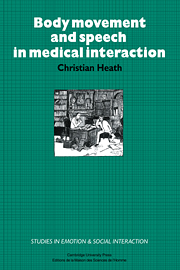Book contents
- Frontmatter
- Contents
- Preface
- The transcription system
- 1 Video analysis: interactional coordination in movement and speech
- 2 The display of recipiency and the beginning of the consultation
- 3 Maintaining involvement in the consultation
- 4 Forms of participation
- 5 The physical examination
- 6 Taking leave of the doctor
- 7 Postscript: the use of medical records and computers during the consultation
- Notes
- References
- Index
1 - Video analysis: interactional coordination in movement and speech
Published online by Cambridge University Press: 19 January 2010
- Frontmatter
- Contents
- Preface
- The transcription system
- 1 Video analysis: interactional coordination in movement and speech
- 2 The display of recipiency and the beginning of the consultation
- 3 Maintaining involvement in the consultation
- 4 Forms of participation
- 5 The physical examination
- 6 Taking leave of the doctor
- 7 Postscript: the use of medical records and computers during the consultation
- Notes
- References
- Index
Summary
If society is conceived as interaction among individuals, the description of the forms of this interaction is the task of the science of society in its strictest and most essential sense.
Simmel 1950, pp. 21-2This work is part of a program of work undertaken several years ago to explore the possibility of achieving a naturalistic observational discipline that could deal with the details of social action(s) rigorously, empirically, and formally. … Our analysis has sought to explicate the ways in which the materials (records of natural conversations) are produced by members in orderly ways that exhibit their orderliness and have their orderliness appreciated and used, and have that appreciation displayed and treated as the basis for subsequent action.
Schegloff and Sacks 1973/1974, pp. 233–4I want to argue that however rich a researcher's imagination is, if he uses hypotheticalized, typicalized versions of the world, he is constrained by reference to what an audience, an audience of professionals, can accept as reasonable. That might not appear to be a terrible constraint, except when we come to look at the kinds of things that actually occur. Many of the objects we work with would not be accepted as a base for theorizing if they were urged as imagined. We can then come to see that a warrant for using close looking at the world as a base for theorizing about it is that from close looking at the world we can find things that we couldn't, by imagination, assert were there. One wouldn't know they were “typical.”
Sacks, quoted in Jefferson 1983b, pp. 17–18- Type
- Chapter
- Information
- Body Movement and Speech in Medical Interaction , pp. 1 - 24Publisher: Cambridge University PressPrint publication year: 1986



